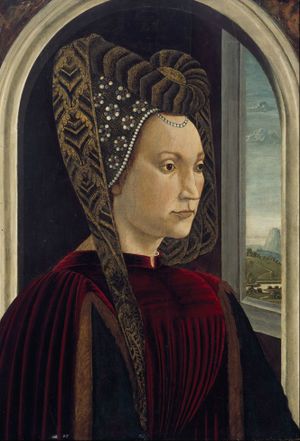كلاريتشه أورزيني
كلاريتشه أورزيني Clarice Orsini | |
|---|---|
 | |
| وُلِد | 1450 مونتىروتوندو، الدويلات الپاپوية |
| توفي | 30 يوليو 1488 (عن عمر 34) فلورنسا، الجمهورية الفلورنسية |
| دُفِن | 1 Aug 1488 |
| الأسرة النبيلة | أورزيني (بالميلاد) مديتشي (بالزواج) |
| الزوج | لورنزو ده مديتشي |
| الأنجال | لوكريتسيا ده مديتشي پييرو دى مديتشي Maddalena de' Medici Contessina Beatrice de' Medici جوڤاني ده مديتشي، الپاپا ليو العاشر Luisa de' Medici Contessina de' Medici جوليانو دى مديتشي، دوق نيمور |
| الأب | Jacopo Orsini, Lord of Monterotondo and Bracciano |
| الأم | Maddalena Orsini |
كلاريتشه أورزيني (Clarice Orsini؛ ولدت في لاتسيو، حوالي 1453 - توفيت في فلورنسا، 30 يوليو 1488) زوجة لورنزو ده مديتشي (لورنزو الرائع) الحاكم الفعلي لجمهورية فلورنسا. ووالدة البابا ليو العاشر.
حياتها
Clarice and Lorenzo married 4 June 1469,[1] with a four-day celebration.[2] The marriage was arranged by Lorenzo's mother Lucrezia Tornabuoni, who wanted her eldest son to marry a woman from a noble family to enhance the social status of the Medicis.[3] Their marriage was unusual for Florence at the time in that they were nearly the same age.[2] Clarice's dowry was 6,000 florins.[1]
The political nature of her marriage meant that she was often called upon by each side of her family to influence the other.[4] This included Lorenzo helping her brother Rinaldo get selected as Archbishop of Florence.[5] She was also called on by others throughout the area to support their requests to her husband.[6] People sought her support in the easing of taxes and releasing family members from exile or prison.[7] She would also use her network to gather information about political and military events away from where she was, including troop movements and battles.[8]
Clarice's religious upbringing was a bit in contrast with the humanist ideals of the age popular in Florence. [9] Nevertheless, sources and letters suggest that there was a great deal of affection and respect between her and Lorenzo. [10] [11] Of the ten children born to them, four died in infancy.
During the Pazzi conspiracy, which was aimed at murdering Lorenzo and his younger brother Giuliano, Clarice and her children were sent to Pistoia. (The Pazzis succeeded in murdering Giuliano, but Lorenzo survived the attack, thus the conspirators' plan to replace the Medicis as de facto rulers of Florence failed).
Clarice returned to Rome several times to visit her relatives; she also visited Volterra, Colle Val d'Elsa, Passignano sul Trasimeno, and other places in the 1480s.[12] During these visits, she was treated as a representative of her husband, an unusual role for a woman in that time and place.[13]
On 30 July 1488 she died in Florence, and was buried two days later.[14] Her husband was not with her when she died, nor did he attend the funeral,[14] because he himself was very ill and was in Bad Filetta near Siena to get cured.
The fact that Lorenzo was away from home when she died, affected even more his mood. Piero da Bibbiena, private chancellor of the Magnificent, wrote the following letter to the Florentine Ambassador in Rome :
Yesterday morning at 2 pm Clarice died. If you hear Lorenzo blamed for not being present at the death of his wife, excuse him. It seemed necessary...that he brought water from the Villa; and no one thought that she would die so soon.
In a letter to Pope Innocent VIII he wrote that he dearly missed his late wife.[15] The content of Lorenzo's letter to the Pope is the following:
The death of my dearest and sweetest wife Clarice, that recently happened to me, it is of so much damage, prejudice, and pain for infinite reasons, that it has overcome my patience and resistance to the troubles and persecutions of fate, for which I did not think that I would be so affected. And this, to be deprived of such sweet habits and companionship...made me feel, and currently makes me feel, as if I'm lost.
السلف
| سلف كلاريتشه أورزيني | ||||||||||||||||||||||||||||||||||||||||||||||||||||||||||||||||||||||||||||||||||||||||||||||||||||||||||||||||||||||||||||||||||||||||||||||||||||||||||||||||||||||||||||||||||||||||||||||||||||||||||||||||||||||||||||||||||||||||||||||||||||||||||||||||||||||||||||||||||||||||||||||||||||||||||||||||||||||||||||||||||||||||||||||||||||||||||||||||||||||||||||||||||||||||||||||||||||||||||||||||||||||||||||||||||||||||||||||||||||||||||||||||||||||||||||||||||||||||||||||||||||||||||||||||||||||||||||||||||
|---|---|---|---|---|---|---|---|---|---|---|---|---|---|---|---|---|---|---|---|---|---|---|---|---|---|---|---|---|---|---|---|---|---|---|---|---|---|---|---|---|---|---|---|---|---|---|---|---|---|---|---|---|---|---|---|---|---|---|---|---|---|---|---|---|---|---|---|---|---|---|---|---|---|---|---|---|---|---|---|---|---|---|---|---|---|---|---|---|---|---|---|---|---|---|---|---|---|---|---|---|---|---|---|---|---|---|---|---|---|---|---|---|---|---|---|---|---|---|---|---|---|---|---|---|---|---|---|---|---|---|---|---|---|---|---|---|---|---|---|---|---|---|---|---|---|---|---|---|---|---|---|---|---|---|---|---|---|---|---|---|---|---|---|---|---|---|---|---|---|---|---|---|---|---|---|---|---|---|---|---|---|---|---|---|---|---|---|---|---|---|---|---|---|---|---|---|---|---|---|---|---|---|---|---|---|---|---|---|---|---|---|---|---|---|---|---|---|---|---|---|---|---|---|---|---|---|---|---|---|---|---|---|---|---|---|---|---|---|---|---|---|---|---|---|---|---|---|---|---|---|---|---|---|---|---|---|---|---|---|---|---|---|---|---|---|---|---|---|---|---|---|---|---|---|---|---|---|---|---|---|---|---|---|---|---|---|---|---|---|---|---|---|---|---|---|---|---|---|---|---|---|---|---|---|---|---|---|---|---|---|---|---|---|---|---|---|---|---|---|---|---|---|---|---|---|---|---|---|---|---|---|---|---|---|---|---|---|---|---|---|---|---|---|---|---|---|---|---|---|---|---|---|---|---|---|---|---|---|---|---|---|---|---|---|---|---|---|---|---|---|---|---|---|---|---|---|---|---|---|---|---|---|---|---|---|---|---|---|---|---|---|---|---|---|---|---|---|---|---|---|---|---|---|---|---|---|---|---|---|---|---|---|---|---|---|---|---|---|---|---|---|---|---|---|---|---|---|---|---|---|---|---|---|---|---|---|---|---|---|---|---|---|---|---|---|---|---|---|---|---|---|---|---|---|---|---|---|---|---|---|---|---|---|---|---|---|---|---|---|---|---|---|---|---|---|---|---|---|---|---|---|---|---|---|---|---|---|---|---|---|---|---|---|---|---|---|---|---|---|---|---|---|---|---|---|---|---|---|---|---|---|---|---|---|
| ||||||||||||||||||||||||||||||||||||||||||||||||||||||||||||||||||||||||||||||||||||||||||||||||||||||||||||||||||||||||||||||||||||||||||||||||||||||||||||||||||||||||||||||||||||||||||||||||||||||||||||||||||||||||||||||||||||||||||||||||||||||||||||||||||||||||||||||||||||||||||||||||||||||||||||||||||||||||||||||||||||||||||||||||||||||||||||||||||||||||||||||||||||||||||||||||||||||||||||||||||||||||||||||||||||||||||||||||||||||||||||||||||||||||||||||||||||||||||||||||||||||||||||||||||||||||||||||||||
الهامش
- ^ أ ب Pernis & Adams 2006, p. 73.
- ^ أ ب Tomas 2003, p. 19.
- ^ Tomas 2003, p. 18-19.
- ^ Tomas 2003, p. 44.
- ^ Tomas 2003, p. 59.
- ^ Tomas 2003, p. 51.
- ^ Tomas 2003, p. 51,62.
- ^ Tomas 2003, p. 61-62.
- ^ Walter, Ingeborg (2005). Lorenzo il Magnifico e il suo tempo (in الإيطالية). Donzelli Editore. p. 66. ISBN 978-88-7989-921-5.
- ^ Hare, Christopher (December 2008). The Most Illustrious Ladies of the Italian Renaissance. Cosimo. p. 61. ISBN 9781605204758.
- ^ Hook, Judith. Lorenzo de' Medici : an historical biography. H. Hamilton. p. 36. ISBN 0241112184.
More solid evidence of a warm and close relationship would seem to exist in the regular annual production, interrupted only by miscarriages, of new inmates for the Medici nursery, and in the concern shown for each other in the correspondence of husband and wife. When Lorenzo was away, Clarice worried ceaselessly about his health and his state of mind, and regularly dispatched presents, food and comforts to him. He, for his part, wrote to her regularly and, no matter how tired he was, normally with his own hand, always addressing these letters to 'my very dear wife'. This warm and close relationship could only be strengthened by the common delight which both parents took in their seven offspring.
- ^ Tomas 2003, p. 31.
- ^ Tomas 2003, p. 31-32.
- ^ أ ب Tomas 2003, p. 24.
- ^ Ingeborg Walter: Der Prächtige – Lorenzo de’ Medici und seine Zeit. München 2005, S. 250.
المصادر
- Pernis, Maria Grazia; Adams, Laurie (2006). Lucrezia Tornabuoni De' Medici and the Medici Family in the Fifteenth Century. New York: Peter Lang Publishing, Inc. ISBN 978-0820476452.
{{cite book}}: Invalid|ref=harv(help) - Tomas, Natalie R. (2003). The Medici Women: Gender and Power in Renaissance Florence. Aldershot: Ashgate. ISBN 0754607771.